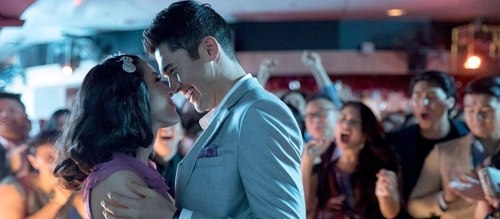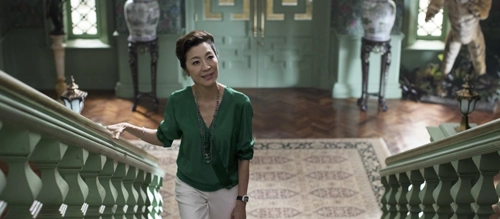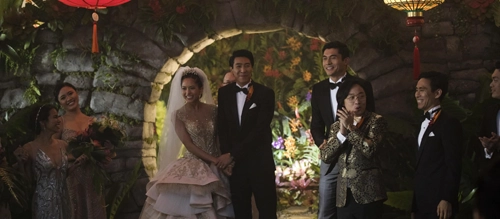‘Crazy Rich Asians’ at 5 – Review

Crazy Rich Asians (2018)
Director: Jon M. Chu
Screenwriters: Peter Chiarelli, Adele Lim
Starring: Constance Wu, Henry Golding, Michelle Yeoh, Gemma Chan, Lisa Lu, Awkwafina, Ken Jeong, Sonoya Mizuno, Chris Pang, Jimmy O. Yang, Ronny Chieng, Remy Hii, Nico Santos
Five years ago today, as the much-anticipated adaptation of Kevin Kwan’s New York Times bestseller Crazy Rich Asians packed cinemas everywhere, Karen K. Ho at Time Magazine announced that this film was ‘going to change Hollywood.’ Her proclamation may sound bold, but as the first American release featuring an all-Asian cast since The Joy Luck Club in 1993, Crazy Rich Asians appeared to signal a sea change brewing in Los Angeles.
In Donald Trump’s pre-pandemic America, divided attitudes toward immigration, race, and diversity dominated news cycles and contributed to the country’s growing political chasm. On one side of the fissure, people of all ethnic backgrounds demanded rights and representation that were long overdue, whilst many on the other side perpetuated the president’s lies that ‘outsiders’ would threaten their freedom and way of life.
In the world of entertainment, Lin-Manuel Miranda’s groundbreaking Broadway hit “Hamilton” professed that immigrants ‘get the job done’ and, also in 2018, Black Panther broke blockbuster records with Marvel’s first Black superhero. Throughout the 2010s, Kwan’s satirical novel became an international sensation, selling millions of copies worldwide within and outside of the pan-Asian community. It quickly became clear that there was an urgent need to tell more people’s stories and to tell them right.
Jon M. Chu’s glitzy, heartwarming rom-com tells one of those stories. Relatable protagonist Rachel Chu (Constance Wu), the immigrant Chinese-American daughter of a single mother, has it all living in New York City with her dream job as an economics professor and a handsome boyfriend, Nick Young (Henry Golding). A down-to-earth fellow professor, Nick wants to finally introduce Rachel to his friends and family back home in Singapore, so she agrees to fly halfway around the world for his best friend’s wedding. Not until their 19-hour flight does she find out that the Young family is rich—crazy rich—and one of the wealthiest old-money families in the country.
Touching down in the bustling city-state, the couple connects with best friend Colin (Chris Pang) and his fiancée Araminta (Sonoya Mizuno). Their laid-back happy reunion comes to a grinding halt, however, when Rachel finally meets Nick’s sophisticated and intimidating mother, Eleanor (Michelle Yeoh), at an elegant soirée held at the family estate. With the help of Rachel’s uni friend, Peik Lin (Awkwafina), and Nick’s kind, selfless cousins Astrid (Gemma Chan) and Oliver (Nico Santos), the heroine must navigate the complicated social mores of Singapore’s ultra-elite, survive an extravagant, out-of-control bachelorette party, and determine whether her relationship with Nick can withstand the pressures of background, class, and family.

Right off the top, the film makes its intention clear with Napoleon Bonaparte’s quote, ‘Let China sleep, for when she wakes, she will shake the world.’ We are then taken back in time to a stormy night in 1995 London. Eleanor, her sister-in-law Felicity (Janice Koh), and their young children Nick and Astrid, seek refuge in the prestigious Calthorpe Hotel. Immediately, the bigoted lobby staff ask the family to leave and threaten to call the police. After Eleanor makes an angry call from a telephone box outside, they return to the Calthorpe and, much to the staff’s dismay, reveal that the Young family are now the proud owners of the posh hotel.
This cheeky scene inverts many of the cultural and racial prejudices previously set by Hollywood pictures. For as long as there have been films, they have consistently portrayed Asian people and cultures as paradoxically both weak and dangerous, as well as a mysterious and exotic ‘other’ on which the Eurocentric Western culture can contrast itself as superior. In this scene, and throughout the film, director Chu shows us that Asia is dignified, powerful, and a force to be reckoned with, yet also familiar and empathetic. By asking an audience of all ethnic backgrounds to align with Rachel, Nick, and Eleanor as the heroes of this story—as audiences have been asked to do with white protagonists for decades—the film humanizes people who have been routinely dehumanized by Hollywood in the past, and guides us in sharing their joys, obstacles, heartaches, and successes.
Importantly, Crazy Rich Asians also portrays the diverse experiences of Asian women across generations. The narrative follows Rachel’s Cinderella story from a single-parent household to Nick’s life of extreme wealth and privilege. Astrid, an Audrey Hepburn type with effortless class and a kind heart, undergoes meaningful growth into a stronger, more independent woman. And Eleanor, the main antagonist to Rachel and Nick’s relationship, is the most complex of all. Though she is old-fashioned and often hurtful in her biting criticisms and unkindness toward Rachel, we can sympathize with the matriarch’s genuine effort to protect her family and to ensure that her son’s life is easier than her own while balancing modern individualism with traditional collective duty.
These compelling characters are a far cry from the stereotypes of Asian women traditionally perpetuated by Hollywood cinema. Since the silent film era, the onscreen representation of East Asian women has been restricted to narrow archetypes. In Sonia Rao’s article for The Washington Post, scholar Celine Parreñas Shimizu describes them as ‘the lotus blossom being a submissive, compliant sex object. The dragon lady being an evil, threatening sex object.’ More recently, the media has also introduced the stereotype of the ‘model minority,’ which idealizes Asian immigrants as inherently smart and, problematically, as a loosely homogenous ethnic group that assimilates easily into American society. In Crazy Rich Asians, the heroines may be smart, beautiful, and powerful, but they are also funny, compassionate, imperfect, and complicated.
Beyond the humanistic themes at the film’s core, Chu paints an exciting, colourful story world that catches our attention and refuses to let go. From the moment Rachel and Nick set foot in Singapore, an endless parade of designer fashion, flashy sports cars, and private jets marches across the screen. The book’s author, Kevin Kwan, spent his early childhood in the Southeast Asian country and, like Nick Young, was born into one of the oldest, wealthiest families on the island. He told Nosheen Iqbal at The Guardian that ‘everything is inspired by things I’ve seen, or experiences I’ve been part of in a roundabout way.’ The extravagant lives of Singapore’s über-wealthy jump right off the pages of his book thanks to the stunning spectacle created by Chu, costume designer Mary Vogt, and production designer Nelson Coates.
The film makes some changes to the original text, most notably with Astrid’s subplot and parts of the ending, but these changes suit the conventions of the rom-com genre, as well as the two-hour time limit. However, one critical change from the book is the shift away from the layered complexities of Singapore’s class and ethnic hierarchies, as well as the country’s international relations and the pan-Asian diaspora within the continent and beyond.
Instead, Rachel’s fish-out-of-water story becomes the narrative’s driving force.
In an impactful scene where Rachel finally confronts Eleanor over a game of mahjong, Rachel describes herself as ‘a poor, raised-by-a-single-mother, low-class, immigrant nobody.’ Following the overarching trends of the time set by other late-2010s artistic works like “Hamilton”, The Big Sick, and later Knives Out, this film asks us to sympathize with Rachel’s Asian American, immigrant experience. As the central focus of a major motion picture, this perspective can act as a point of reference for thousands of immigrants and children of immigrants who did not have significant representation onscreen before. Still, it is important to note that this shift means the film lacks a genuine portrayal of the nuances found in the region’s diverse society, which Kwan’s book depicts with tact and depth.
In addition to all the things the film does well, it has faced legitimate criticism for not only missing details, but for also contributing to the often problematic nature of the city-state’s class and ethnic hierarchies. According to Hannah Ellis-Petersen and Lily Kuo at The Guardian, some viewers in Singapore and across Asia have decried the film for perpetuating the stereotypes it claims to reverse, namely how the decadent excess of the story’s ultra-rich ensemble continues to exoticize Asian people in the media.
Ellis-Petersen and Kuo also reveal that many activists have taken issue with the marginalization of the country’s Malay and Indian population as either servants and guards, or as entirely invisible from the narrative. The glamorous, westernized characters at the centre of the story are largely of Chinese descent and feature relatively light skin tones (which warrants a larger conversation about colourism in cinema than this article can provide). For a film that aims to dismantle the racial hierarchies raging in the United States, it does so at the expense of other minorities abroad. In an interview with Debanjali Bose at Insider, Chu says he regrets casting South Asian actors in subservient roles and should have depicted them in a ‘more human’ light.
What many of these criticisms reveal is that, at its core, this film is a Hollywood film made for an American audience with a surface-level image of Asia that Western audiences could ‘comfortably’ recognize.
Keeping its international failings in mind, the film did positively impact members of the Asian diaspora in Western countries. Jiayang Fan at The New Yorker admits that whilst ‘a two-hour movie […] can’t be all things to all people,’ she revelled in the film’s ‘inversion of racial expectation,’ which led her to investigate her own Asian American identity. Oscar winner Ke Huy Quan also claims that he had once quit the industry due to the scarcity of film roles for Asian actors, but seeing this film’s sensitive portrayal of Asian characters brought him back to the profession.

Looking back, did Crazy Rich Asians indeed ‘change Hollywood’ as Karen K. Ho hoped? In 2021, Sakshi Venkatraman at NBC News reported that a recent study of the top-grossing films from the 2010s found that ‘Asians on screen often serve as the punchline or the butt of the joke.’ And, if Disney’s Mulan live-action remake’s spectacular failure in Asia serves as any indication, there is a lot more Hollywood needs to do to consider its global audience beyond its own national borders.
Despite these setbacks, since Crazy Rich Asians’ release in 2018, Asian actors have helmed popular projects like Always Be My Maybe, The Farewell, ‘Beef’, and the To All the Boys series. Members of the Indian diaspora have found the spotlight in Netflix television programmes like ‘Bridgerton’ season two and Mindy Kaling’s ‘Never Have I Ever’. In 2020, Parasite became the first non-English language and East Asian film to win the Academy Award for Best Picture, and more recently, the smash hit Everything Everywhere All at Once, starring a predominantly Asian cast including Crazy Rich Asians alum Michelle Yeoh, swept the Oscars with seven total wins.
Change is slow and there is still much more to be done to create a more equitable entertainment industry in Hollywood and abroad. But, five years later, it seems that this funny, extravagant, heartwarming, important rom-com was a giant leap in the right direction.
Score: 20/24

